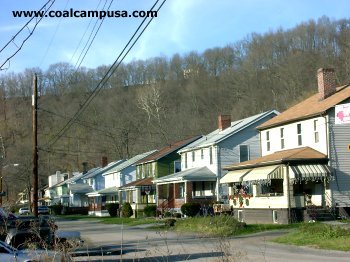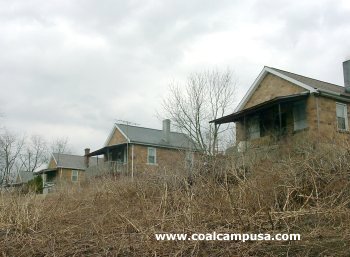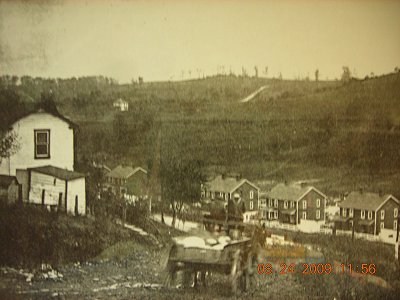MISC. PITTSBURGH FIELD PAGE 2
Gob piles and company houses remaining from the Pittsburgh Coal Company's coal mining operations at Moon Run, Robinson Township, Penna. This scene, which
appears to be rural Appalachia, is actually less than 10 miles from downtown Pittsburgh.
Abandoned barge loading facility on the Monongahela River at Naomi. Moving coal by barge is the most economical way of shipment.
Coal barges are moved down the Monongahela River through a system of locks, such as this one - Lock No. 4. In the background is the city of Charleroi, PA.
Some of the many company-built houses in Arnold City patch. The Pittsburgh Coal Company built Arnold City in or around 1900, and the mine there closed in 1942. The company-built
housing may have also been associated with Hillman Coal and Coke Company's Naomi Mine.
The Smithdale patch, on the banks of the Youghiogheny River in southern Allegheny County. With it's Pennsylvania duplex housing, slate dump, and "Honor Roll," it looks like
most other patches.
This building on the edge of Carnegie, Pa. once held the blacksmith shop, carpenter shop, motor barn, and supply house for the Mansfield Coal & Coke Company's Mansfield Mine.
Later it was a Pittsburgh Coal Co. property.
Here's the Mansfield mine puking out AMD and not really doing the Chartiers Creek watershed any favors.
The Pittsburgh Coal Company built these houses on the edge of Smithton Boro.
These crumbling coke ovens in the Youghiogheny Gorge are near Smithton, PA.
Unusual yellow brick cottages built by the American Reduction Company for Company store at Van Meter, PA, along the Youghiogheny River. Most of the patch housing is still there. You will see it if you ride your bike along the
Yough River Trail.
This huge slate dump contains the refuse of the Pittsburgh Coal Company's Banning No. 3 mine.
Abandoned preparation plant and a really huge refuse pile were part of Pittsburgh Coal Company's Banning No. 4 mine near
West Newton, PA.
This is how the Banning No. 4 site looked in April 2002. Bankrupt LTV Steel (ISG now, I guess) has been in charge of the site.
"Train Man" writes, "I see you have visited the Banning 4 complex near West Newton. My wife being from that area and naturally my interest in coal mining has brought me to
that site many of times after its closure and before the trail. I hope you don't mind me sharing a few paragraphs with you about Banning No. 4. My first visit was in 1981, which was a drive-by and
quick turn around. I was met by a polite security guard who let me take a quick look before he sent me on my way. What I remember the most was all the mining equipment outside the mine near the slope entrance. Frequent
visits by walking in came in the early 90's. It was naturally an open invite at that time. It looked like Republic Steel just walked away. Miners records, blue prints, maps, reports and so on were scattered about the different buildings. The shower house with the hanging baskets still had shampoo, soap containers and shower slippers in them. The slope was sealed. However, a crushing wheel and dump station was built in the slope location. I understand it was never used.
I've retained blue print drawings of the slope entrance with its combination track and conveyor system. Also the blue prints show the dump station within the mine. I would have to dig them out, but I believe they were dated 1960 or 61. The most interesting blue print is the mines proposed surface arrangement, dated 15 Feb 1961. I also came across safety inspection reports that were dated 28 & 29 May 1975 which revealed alot of information about the mines activities and workings. Here is some of the information:
Mine: Banning No. 4
Company: Republic Steel Corp
Location: West Newton, Westmoreland County, PA
Daily Production: 3,000 tons
Surface Employment: 59
Underground Employment: 253
No. of active sections: 6
Type of Mine: 1 Slope, 3 Shafts
Name of Coalbed: Pittsburgh
Thickness of Coalbed: 84 inches
No. of Production Shifts: 3
A friend who works for the DEP told me that the mine closed due to water from the Yough River entering the workings and Republic Steel closed it down. I know treatment stations at the site and another near Reduction are still maintained and working to this day to treat the water."
Ruins of the Pittsburgh Coal Company's Banning No. 1 coal mine along the Youghiogheny River. This was also the site
of the infamous Darr Mine Disaster.
Slate dump on the edge of McDonald, PA.
Company duplexes in the Duck Hollow section of Imperial, PA in western Allegheny County.
This brick building near Imperial was once the Dickson Mine power house. Dickson mine was once an Imperial Coal Co. operation and later, of course, was
taken over by Pittsburgh Coal Co.
There is nothing left of the Pittsburgh Coal Company's Montour No. 9 mine except for these coal company houses.
Sealed mine portal in Essen, PA, near the intersection of Painters Run Road and Bower Hill Road.
One of the last houses built by the Pittsburgh Coal Co. in Essen, PA.
A scene from long ago in the Pittsburgh Terminal Railroad & Coal Company's No. 5 patch town at Curry, PA. The
patch houses still exist along Brownsville Road near South Park.
The patch houses from Curry No. 5 mine still exist today. One of them is even a law firm's office. They have been enveloped by the suburbs of Pittsburgh.
The coal refuse pile, or "slate dump," remains from the Reissing Mine that used to be in Cecil Township, Washington County.
Ron sent in this photo of a sealed railroad tunnel that has been mistakenly labeled, "Caution Mine Opening."
An ancient ventilating fan along the Monongahela River.
This photo, taken while I was stuck in traffic on Route 51, is of a church on the edge of Pittsburgh that is the only remaining structure from
the Fairhaven coal mining town.
Former Pittsburgh Terminal Railroad & Coal Co. No. 7 patch town.
This coke plant in Monessen was originally part of Pittsburgh Steel Company, then later
Wheeling-Pittsburgh Steel, and in the 1990s until 2008 Koppers, and finally Arcelor-Mittal.
This tipple on the Mon River of the Gilmore Mine was as basic as it got. Gilmore Mine, in North Webster, Pa., opened in 1871.
Coal patch town at Gibson, Pa. The Gibson mine was opened by the Hillman Gas Coal Co. around 1921.
Former Pittsburgh Coal Company store at Wickhaven, Pa.

Oct. 2009 image by author

Mar. 2003 image by author

Jul. 2004 image by author

June 2002 image by author

May 2004 image by author

Feb. 2016 image by author

Feb. 2016 image by author

Nov. 2003 image by author

Nov. 2003 image by author

Nov. 2004 image by author
the workers of the Reduction mine are perched on a cliff overlooking the Youghiogheny River gorge I now realize that this was
a company town, but not for a coal mine. The houses were for the workers of an incenerator and rendering plant that handled Pittsburgh's garbage.

Mar. 2003 image by author

Mar. 2003 image by author

Image courtesy Coal and Coke Heritage Center, Penn State Eberly Campus

Apr. 2002 image by author

Mar. 2010 image by "Trains & Trails" via Flickr

Aug. 2004 image by author

Aug. 2004 image by author

Feb. 2016 image by author

Aug. 2004 image by author

Sep. 2005 image by author
Detail of original slate roof on a patch house in Manifold, PA. This coal patch in South Strabane Twp. was once operated by the Youghiogheny & Ohio Coal Company. The mine has been closed
for years and the patch is now surrounded by sleek modern suburbs.

Sep. 2005 image by author

Sep. 2005 image by author

Image courtesy of Ron Franko

Jan. 2010 image by author

Jan. 2010 image by author

Image courtesy of Ron Franko

Image courtesty of Sam Baker

Feb. 2016 image by author

Image courtesy of phms.peterscreek.org

Dec. 2003 image by author

Circa 1884 image from "Report on the Coal Mines of the Monongahlela River Region"

Mar. 2018 image by author

Mar. 2018 image by author